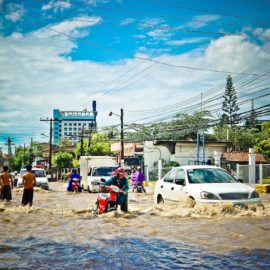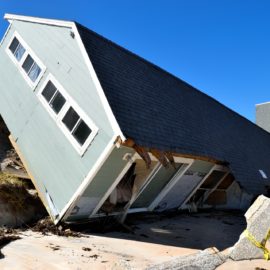
Flood insurance gives us peace of mind but the increases are going to cost a lot creating a lack of peace of mind.
Parish presidents from across the New Orleans metro area joined together Tuesday to raise alarm over the “stupidity” of new flood insurance rates starting to take effect this week that will lead to steep hikes for many, warning the changes could devastate communities and calling for a delay in implementation. Louisiana is set to see a major impact from the drastic overhaul of the nation’s flood insurance program, in part because it has the highest participation rate in the program of any state. The new rates begin to take effect for existing policyholders on Friday, though not all at once. The state’s roughly 500,000 policyholders – comprising 10% of the nation’s total – will see the start of the change with their next renewal after March 31. Increases are capped at 18% annually, but many are expected to take years to reach their “target rate” at that percentage, and in those cases, compounded hikes will add up to large numbers over time. Sticker shock is already being seen with new policies, which began to be priced at the new rates in October and are not subject to the 18% limit. Residents, realtors and insurers are reporting major increases, with premiums at certain properties jumping from around $600 per year to $3,000 or more. Yet few understand the changes in the highly complex new system – and that is a major point of contention.
nola.com
Parish leaders are speaking out against the increases which they fear will drive home owners out of their homes.
Parish leaders from Jefferson, Lafourche, St. Charles, St. John the Baptist, St. Tammany, Tangipahoa, Terrebonne and St. Bernard, along with a representative from New Orleans Mayor LaToya Cantrell’s office and state Insurance Commissioner Jim Donelon, gathered for a news conference in Metairie to issue the warning. Greater New Orleans Inc., the regional economic development group that has been working to raise awareness of the issue, organized the effort. The organization’s CEO, Michael Hecht, said they are seeking a delay until further information is provided, plus assistance for those who can’t afford the increases and more transparency. St. Bernard Parish President Guy McInnis pointed to rebuilding efforts since Hurricane Katrina, particularly fast growth in Arabi, where last week’s tornado hit. He said the new flood rates would be “a reason to leave” because of the added cost of buying a home. “It’s stupidity, and we need to fix that,” he said.
If you complain, use the right name: Risk Rating 2.0.
The new system, known as Risk Rating 2.0, marks the biggest change to how the National Flood Insurance Program sets rates in its history. Donelon said he does not understand how factors such as levees and elevations are being accounted for when setting rates in the new system. A complex algorithm is being used, and FEMA, which oversees the program, has been heavily criticized for a lack of transparency surrounding it. The state’s congressional delegation has long been seeking to delay the changes and further limit the cap on annual increases. Another bill was introduced this week, with Sens. Bill Cassidy and John Kennedy among the sponsors, that would allow policyholders to remain at their current rates until FEMA can provide further transparency and accountability. In the House, U.S. Rep. Garret Graves, R-Baton Rouge, has been among those seeking to stop the increases.
Fairness. A wonderful thing but that is what the increases are based on.
The idea behind the changes is to make the program fairer by accurately factoring in the risk of each individual property. While rates were set in the past based largely on a system of maps, Risk Rating 2.0 takes into account the individual characteristics of each home, including distance from water, construction type, elevation and cost to rebuild. FEMA says the existing system resulted in older, modest homes essentially subsidizing premiums for newer, expensive vacation houses, and Risk Rating 2.0 will correct that. It will also allow the deeply indebted NFIP to price policies more in line with private sector actuarial practices, helping it become more solvent. But the state’s political leaders, along with residents who have seen some of the increases, warn of unintended consequences for south Louisiana, where everyone lives near water of some kind. In certain cases, living near water may be a good thing in this part of the country, such as on the natural ridges near the Mississippi River. It is unclear how FEMA takes such characteristics into account.
FEMA is not totally transparent as they are only doing monthly due to the 18% cap.
FEMA has only published data on monthly increases and decreases for the first year. That masks the long-term impact, because of the 18% cap. Using data provided so far, an analysis by The Times-Picayune | The Advocate shows that around half of the state’s policyholders are expected to see phased-in increases that will total more than 129%. About one in 10 could see their premiums jump by more than four times their current amount, while around 20% are expected to see decreases. “People don’t realize what’s about to happen to them,” said Jefferson Parish President Cynthia Lee Sheng, whose parish represents about 20% of the state’s policies. She said she believes many will simply drop coverage if they live in zones where it is not required. “They’re going to be going against their own financial interest, but because they can’t afford it,” said Lee Sheng.
I am not looking forward to seeing my increase.



